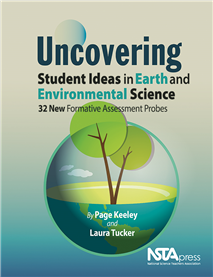All Book Chapters
Book Chapter
The purpose of this assessment probe is to elicit students’ ideas about layers of sedimentary rock. The probe is designed to find out how students think about the age of rock layers. It is best used with grades 6–12, and students should be famili...
Book Chapter
The purpose of this assessment probe is to elicit students’ ideas about erosion. The probe is designed to find out whether students can distinguish between erosion and weathering. When rock material is broken down or changed, but not transported to...
Book Chapter
The purpose of this assessment probe is to elicit students’ ideas about weathering. The probe is designed to find out whether students recognize that plants, including small plants, can cause weathering of rock. Plant roots as they grow larger can ...
Book Chapter
The purpose of this assessment probe is to elicit students’ ideas about the formation of the Grand Canyon and is specific to the Grand Canyon. The probe is designed to find out if students recognize the role of rivers and flowing water and connect...
Book Chapter
The purpose of this assessment probe is to elicit students’ ideas about processes that change Earth. The probe is designed to find out if students recognize that the sand on many beaches results from weathering of rock on mountains, erosion, and de...
Book Chapter
The purpose of this assessment probe is to elicit students’ ideas about rivers. The probe is designed to find out how students think most rivers formed and can be used with grades 3–12. It is helpful to show a photograph of a river when presentin...
Book Chapter
What is the Inside of Earth Like?
The purpose of this assessment probe is to elicit students’ ideas about Earth’s structure. The probe is designed to find out if students recognize Earth’s interior is made up of layers and is mostly solid. It is best used with grades 6–12. As...
Book Chapter
The purpose of this assessment probe is to elicit students’ ideas about Earth’s tectonic plates. The probe is designed to uncover commonly held misconceptions about Earth’s plates. Plate tectonics is the unifying theory that explains the past a...
Book Chapter
Where Do You Find the Earth’s Plates?
The purpose of this assessment probe is to elicit students’ ideas about Earth’s plates. The probe is designed to find out where students think tectonic plates are located. Earth is composed of several major, large tectonic plates and several smal...
Book Chapter
What Do You Know About Volcanoes and Earthquakes?
The purpose of this assessment probe is to elicit students’ ideas about plate tectonic features and events. The probe is designed to uncover commonly held misconceptions about volcanoes and earthquakes. If students believe that earthquakes usually ...
Book Chapter
The purpose of this assessment probe is to elicit students’ ideas about Earth’s natural resources. The probe is designed to find out if students can distinguish between renewable and nonrenewable natural resources. It is important students know t...
Book Chapter
The purpose of this assessment probe is to elicit students’ ideas about pollution. The probe is designed to uncover commonly held ideas about acid rain, which is caused when normal rain combines with things in the air that come from pollution. This...
Book Chapter
The purpose of this assessment probe is to elicit students’ ideas about watersheds. A watershed is an area of land where all of the water that is under it or drains off of it goes into the same place. They come in all shapes and sizes and include b...
Book Chapter
The purpose of this assessment probe is to elicit students’ ideas about natural versus human-engineered products. This probe is designed to uncover whether students think natural always means not harmful while some can be quite toxic, not only to i...
Book Chapter
The purpose of this assessment probe is to elicit students’ ideas about the greenhouse effect. The probe is designed to reveal whether students confuse the greenhouse effect with other environmental concerns or lump the concerns together. The green...


